You can create a custom View to draw the circle. I have based my example on Draw transparent circle filled outside
Here you can find a tutorial about how to create custom views.
In my example I am creating a custom RadarOverlayView with a radius parameter that I use to compute the area.
My custom view code:
public class RadarOverlayView extends LinearLayout {
private Bitmap windowFrame;
private float radius = 0f;
private int centerX = 0;
private int centerY = 0;
public RadarOverlayView(Context context) {
super(context);
}
public RadarOverlayView(Context context, AttributeSet attrs) {
super(context, attrs);
TypedArray a = context.getTheme().obtainStyledAttributes(
attrs, R.styleable.RadarOverlayView, 0, 0);
try {
radius = a.getDimension(R.styleable.RadarOverlayView_radius, 0f);
} finally {
a.recycle();
}
}
@Override
protected void dispatchDraw(Canvas canvas) {
super.dispatchDraw(canvas);
if (windowFrame == null) {
createWindowFrame();
}
canvas.drawBitmap(windowFrame, 0, 0, null);
}
@Override
public boolean isEnabled() {
return false;
}
@Override
public boolean isClickable() {
return false;
}
protected void createWindowFrame() {
windowFrame = Bitmap.createBitmap(getWidth(), getHeight(), Bitmap.Config.ARGB_8888);
Canvas osCanvas = new Canvas(windowFrame);
centerX = getWidth() / 2;
centerY = getHeight() / 2;
if (radius > 0) {
Paint paint = new Paint(Paint.ANTI_ALIAS_FLAG);
// Draw the circunference
paint.setStyle(Paint.Style.STROKE);
paint.setColor(Color.RED);
paint.setAlpha(200);
paint.setStrokeWidth(5);
osCanvas.drawCircle(centerX, centerY, radius, paint);
// Draw the circle
paint.setStyle(Paint.Style.FILL);
paint.setColor(Color.RED);
paint.setAlpha(100);
osCanvas.drawCircle(centerX, centerY, radius, paint);
// Draw the center icon
paint.setAlpha(255);
Bitmap centerBitmap = BitmapFactory.decodeResource(getResources(), R.mipmap.ic_launcher);
osCanvas.drawBitmap(centerBitmap, centerX - centerBitmap.getWidth() / 2,
centerY - centerBitmap.getHeight() / 2,
paint);
}
}
@Override
public boolean isInEditMode() {
return true;
}
@Override
protected void onLayout(boolean changed, int l, int t, int r, int b) {
super.onLayout(changed, l, t, r, b);
windowFrame = null;
}
public float getRadius() {
return radius;
}
public int getCenterX() {
return centerX;
}
public int getCenterY() {
return centerY;
}
}
My attrs.xml:
<?xml version="1.0" encoding="utf-8"?>
<resources>
<declare-styleable name="RadarOverlayView">
<attr name="radius" format="dimension" />
</declare-styleable>
</resources>
My activity_maps.xml layout:
<?xml version="1.0" encoding="utf-8"?>
<RelativeLayout xmlns:android="http://schemas.android.com/apk/res/android"
xmlns:tools="http://schemas.android.com/tools"
xmlns:app="http://schemas.android.com/apk/res-auto"
android:layout_width="match_parent"
android:layout_height="match_parent"
android:orientation="vertical">
<fragment
android:id="@+id/map"
android:name="myPackage.MySupportMapFragment"
android:layout_width="match_parent"
android:layout_height="match_parent"
tools:context=".MapsActivity"/>
<myPackage.RadarOverlayView
android:id="@+id/radar"
android:layout_width="match_parent"
android:layout_height="match_parent"
android:layout_centerInParent="true"
app:radius="150dp" />
</RelativeLayout>
My Activity:
public class MapsActivity extends FragmentActivity implements GoogleMap.OnCameraChangeListener {
private GoogleMap mMap;
private RadarOverlayView radarView;
@Override
protected void onCreate(Bundle savedInstanceState) {
super.onCreate(savedInstanceState);
setContentView(R.layout.activity_maps);
radarView = (RadarOverlayView) findViewById(R.id.radar);
setUpMapIfNeeded();
}
@Override
protected void onResume() {
super.onResume();
setUpMapIfNeeded();
}
private void setUpMapIfNeeded() {
if (mMap == null) {
mMap = ((SupportMapFragment) getSupportFragmentManager().findFragmentById(R.id.map))
.getMap();
if (mMap != null) {
setUpMap();
}
}
}
private void setUpMap() {
mMap.setMapType(GoogleMap.MAP_TYPE_HYBRID);
mMap.getUiSettings().setAllGesturesEnabled(true);
mMap.getUiSettings().setZoomControlsEnabled(true);
mMap.setOnCameraChangeListener(this);
}
@Override
public void onCameraChange(final CameraPosition cameraPosition) {
// Compute the area of the circle each time the camera changes
LatLng center = mMap.getProjection().fromScreenLocation(
new Point(radarView.getCenterX(), radarView.getCenterY()));
LatLng right = mMap.getProjection().fromScreenLocation(
new Point(radarView.getCenterX() + Math.round(radarView.getRadius()),
radarView.getCenterY()));
Location locationCenter = new Location("center");
locationCenter.setLatitude(center.latitude);
locationCenter.setLongitude(center.longitude);
Location locationRight = new Location("right");
locationRight.setLatitude(right.latitude);
locationRight.setLongitude(right.longitude);
double geoRadius = locationCenter.distanceTo(locationRight);
double geoArea = Math.PI * Math.pow(geoRadius, 2);
// Uncomment to inspect the difference between
// RadarOverlayView circle and geographic circle:
// mMap.clear();
// Circle circle = mMap.addCircle(new CircleOptions()
// .center(cameraPosition.target)
// .radius(geoRadius)
// .strokeColor(Color.GREEN)
// .fillColor(Color.BLUE));
Toast.makeText(this, "Area: " + geoArea, Toast.LENGTH_SHORT).show();
}
}
The result looks like this and shows a Toast with the area covered by the circle each time the camera changes:

Limitations:
The example is drawing a perfect circle in a View, but this circle is not guaranteed to be geographically accurate depending on the zoom level.
You can see that, at high zoom levels, there is a huge difference between the circle drawn by the custom view and a geographically accurate circle (based on the camera target and radius) if you uncomment the mMap.addCircle code on the onCameraChange method:

This difference that is caused by the projection of the map (WGS84), is huge at high zoom levels, and decreases at lower zoom levels:




